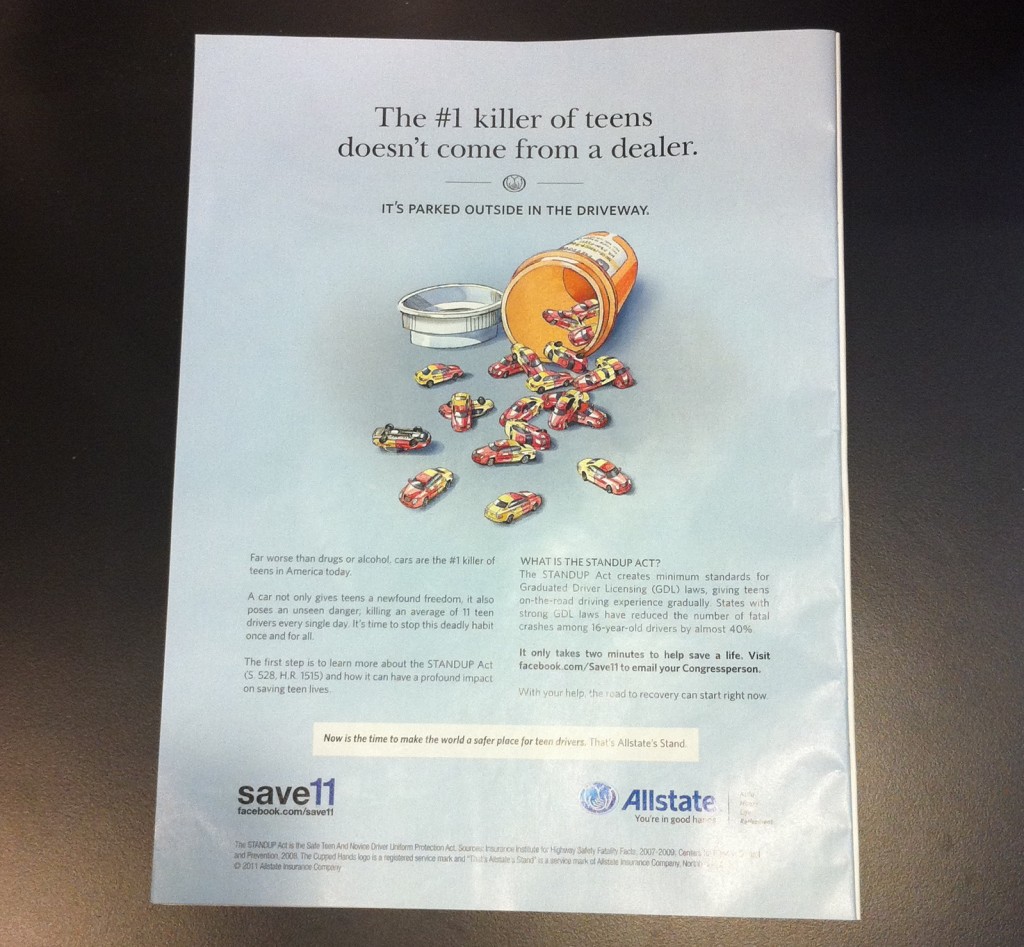.
The advertisement sponsored Allstate Insurance Company, below, appears on page 50 of the July 25, 2011 edition of Time magazine. In it Allstate lends its support to the Save Teen and Novice Driver Uniform Protection Act, federal legislation intended to save teen lives lost to car accidents. I have no quarrel with the sentiment of the ad. What I do have to wonder is, What was the copywriter thinking when she/he came up with this headline? —
.
.
Here’s how I imagine the typical reader encounters and absorbs the ad’s message.
After turning page 49 to look at pages 50-51, the reader likely looks briefly at the left side of the two-page spread, her glance taking in the picture of a prescription drug container spilling its capsule-like contents. OK, the reader now has placed the idea of “drugs” fresh in her consciousness. Then, looking up at the first line of copy (the attention-grabbing words in the largest font), the reader sees the first line’s phrase: “The #1 killer of teens”. The reader blends those two items (drugs + top-teen-killer) and finds they’re compatible. Yes, she’s aware teens die from abuse of drugs, and it’s a big problem. It sounds reasonable to assume drugs are the top killer of teens.
Then comes the writer’s “Gotcha!” moment and it’s a good one: a switcheroo. It tells her she’s mistaken. The split-second link her mind forged is wrong. She looks more carefully at the capsules spilling from the bottle and sees they are miniature cars. At best (the ad writer ought to have predicted) she thinks this odd, but she’ll keep this oddity in mind. But the text calls for her to please keep reading, to be set straight with the correct answer. Helpfully, not only does the second line reveal drugs is NOT the answer to the riddle, but the words guide her in the right direction with a teaser. Not the final answer, mind you, but a clue that will help her find the answer: Think of something unrelated to “a dealer.”
So: the top teen killer is not drugs since their usual source is a dealer (at least if the copywriter wants her to envision hard drugs, and exclude patent drugs stolen from a parent’s medicine cabinet). The answer is some causal agent that does NOT come from a dealer. Think. Think. OK, the reader’s mind goes into second gear, running through the possibilties. Guns? Suicidal behaviors? Violence perpetrated against teens? All good choices; she’ll keep them handy. The clue also helps eliminate possibilities. For example, one not good answer, since it violates the criteria (that a “dealer” cannot be involved), is cars. The majority of cars, new cars certainly, still come from dealers. As for acquiring a used car, this often means checking out the goods of a used car dealer. “Car + dealer” are terms linked in the human mind because the two terms are connected as a matter of routine commerce. So, the top killer of teens is not cars, the reader concludes.
Oops.
It’s hard for me to believe the advertisement’s copywriter intended to confuse and frustrate and anger the reader with a second switch-back (one of ugly temper: “Ha-ha! I fed you a false premise! Try and keep up with the game, sucker!”).
Which means, while this advertisement doesn’t qualify as an Epic Fail, it sure is a plain failure.
.
